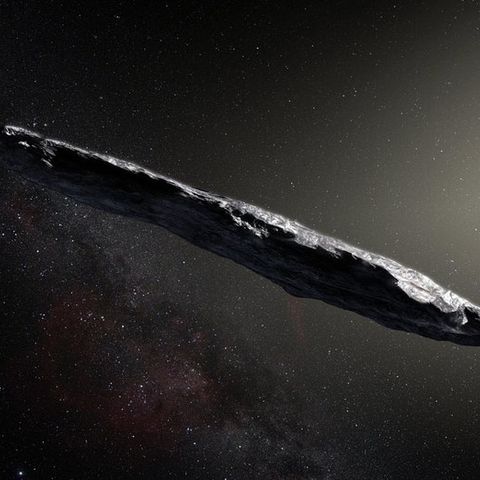UFO Buster Radio News – 265: Oumuamua 2 … Borisov, Who’s Watching?

Descarga y escucha en cualquier lugar
Descarga tus episodios favoritos y disfrútalos, ¡dondequiera que estés! Regístrate o inicia sesión ahora para acceder a la escucha sin conexión.
Capítulos
Descripción
NASA Confirms Newly Discovered Comet Is Likely Interstellar Visitor Link: https://scitechdaily.com/nasa-newly-discovered-comet-is-likely-interstellar-visitor/ The object – designated C/2019 Q4 (Borisov) – was discovered on August 30, 2019, by Gennady Borisov at the...
mostra másLink: https://scitechdaily.com/nasa-newly-discovered-comet-is-likely-interstellar-visitor/
The object – designated C/2019 Q4 (Borisov) – was discovered on August 30, 2019, by Gennady Borisov at the MARGO observatory in Nauchnij, Crimea. The official confirmation that comet C/2019 Q4 is an interstellar comet has not yet been made, but if it is interstellar, it would be only the second such object detected. The first, ‘Oumuamua, was observed and confirmed in October 2017.
The new comet, C/2019 Q4, is still inbound toward the Sun, but it will remain farther than the orbit of Mars and will approach no closer to Earth than about 190 million miles (300 million kilometers).
The comet is currently 260 million miles (420 million kilometers) from the Sun and will reach its closest point, or perihelion, on December 8, 2019, at a distance of about 190 million miles (300 million kilometers).
“The comet’s current velocity is high, about 93,000 mph [150,000 kph], which is well above the typical velocities of objects orbiting the Sun at that distance,” said Farnocchia. “The high velocity indicates not only that the object likely originated from outside our solar system, but also that it will leave and head back to interstellar space.”
Observations completed by Karen Meech and her team at the University of Hawaii indicate the comet nucleus is somewhere between 1.2 and 10 miles (2 and 16 kilometers) in diameter. Astronomers will continue to collect observations to further characterize the comet’s physical properties (size, rotation, etc.) and also continue to better identify its trajectory.
JPL on Oumuamua’s Speed Up
Link: https://www.nasa.gov/press-release/our-solar-system-s-first-known-interstellar-object-gets-unexpected-speed-boost
Using observations from NASA’s Hubble Space Telescope and ground-based observatories, an international team of scientists have confirmed ′Oumuamua (oh-MOO-ah-MOO-ah), the first known interstellar object to travel through our solar system, got an unexpected boost in speed and shift in trajectory as it passed through the inner solar system last year.
“Our high-precision measurements of ′Oumuamua’s position revealed that there was something affecting its motion other than the gravitational forces of the Sun and planets," said Marco Micheli of ESA’s (European Space Agency) Space Situational Awareness Near-Earth Object Coordination Centre in Frascati, Italy, and lead author of a paper describing the team's findings.
Analyzing the trajectory of the interstellar visitor, co-author Davide Farnocchia of the Center for Near Earth Object Studies (CNEOS) at NASA’s Jet Propulsion Laboratory (JPL) found that the speed boost was consistent with the behavior of a comet.
“This additional subtle force on ′Oumuamua likely is caused by jets of gaseous material expelled from its surface,” said Farnocchia. “This same kind of outgassing affects the motion of many comets in our solar system.”
ʻOumuamua is a small object, estimated to be between 100 and 1,000 meters long, with its width and thickness both estimated to range between 35 and 167 meters (328–3,280 ft × 115–548 ft × 115–548 ft).[11] It has a dark red color, similar to objects in the outer Solar System. ʻOumuamua showed no signs of a comet coma (atmosphere) despite its close approach to the Sun, but underwent non-gravitational acceleration.[21][22] This effect is seen in many icy comets,[22][23] although other reasons have been suggested.[24][25][26] Nonetheless, the object could be a remnant of a disintegrated rogue comet (or exocomet), according to a NASA scientist.[27][28]
Show Stuff
The Dark Horde, LLC – http://www.thedarkhorde.com
Twitter @DarkHorde
TeePublic Store - Get your UBR goodies today! http://tee.pub/lic/2GQuXxn79dg
UBR Truth Seekers Facebook Group: https://www.facebook.com/groups/216706068856746
Manny Moonraker: https://www.facebook.com/MannyMoonraker/
UFO Buster Radio: https://www.facebook.com/UFOBusterRadio
YouTube Channel: https://www.youtube.com/channel/UCggl8-aPBDo7wXJQ43TiluA
To contact Manny: manny@ufobusterradio.com, or on Twitter @ufobusterradio
Call the show anytime at (972) 290-1329 and leave us a message with your point of view, UFO sighting, and ghostly experiences or join the discussion on www.ufobusterradio.com
For Skype Users: bosscrawler
Información
| Autor | The Dark Horde Network |
| Organización | The Dark Horde Network |
| Página web | - |
| Etiquetas |
Copyright 2024 - Spreaker Inc. an iHeartMedia Company
